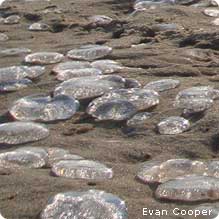We have much more to do and your continued support is needed now more than ever.
Summertime First Aid: Jellyfish Stings
Guest post by Carol Torgan, Ph.D. This article was reviewed by Dr. Joshua Rotenberg, a Texas pediatrician and neurologist.
 Problem: Synchronized swimming with a jellyfish. These beautiful, gelatinous sea creatures have tentacles full of stinging barbs known as nematocysts. Your family may encounter them near the surface of the water or washed up on the beach.
Problem: Synchronized swimming with a jellyfish. These beautiful, gelatinous sea creatures have tentacles full of stinging barbs known as nematocysts. Your family may encounter them near the surface of the water or washed up on the beach.
A mild jellyfish sting typically results in pain (prickly, burning), itching, a rash, and raised welts.
Treatment: Follow these steps if you or a family member gets stung by a jellyfish.
1. Immediately wash the affected area with seawater to remove venom and any remaining tentacles. Don’t use fresh water, rub the area, or apply ice. These will continue to cause the release of jellyfish toxin and increase the pain.
2. For most mild stings from North American jellies, the next step is to treat the area with vinegar (acetic acid), which helps stop the release of toxins. If you don’t have vinegar, you can use rubbing alcohol. Soak a piece of cloth or paper towel and lay it over the area for 30 minutes, or pour the liquid over the area.
3. After the vinegar (and once you get home, hotel or beach house), apply shaving cream or a paste of baking soda and seawater to the affected area. After it dries, scrape the area with a razor or credit card to remove the nematocysts. (The shaving cream or paste prevents nematocysts from releasing toxins during removal with the razor.) In a pinch, you can use sand along with a shell for scraping. Reapply vinegar or rubbing alcohol.
4. Apply calamine lotion or a hydrocortisone cream to decrease pain and skin irritation. Hot-water or ice packs, whichever feels better, can help relieve pain.
Can Urine Calm the Sting? There’s an old wives’ tale that urine can relieve the pain caused by a sting, and thus the treatment of choice is to — umm — pee on the stung area. There is no scientific evidence that this works, although if you ask enough people, someone will tell you that it worked for them. Your best bet is to go with the vinegar.
NOTE: These treatment suggestions are meant for mild reactions to jellyfish stings. If you are not sure whether a sting is mild, please consult with your physician.
Prevention:
- Pack Vinegar: If you frequent areas where jellies hang out, do what the jelly experts do: Pack some household white vinegar in your beach bag.
- Don’t Touch: Don’t pick up or touch dead jellyfish, which can still release toxins.
- Stay Clear: Avoid going into areas where jellies are hanging out. If you aren’t sure, check with the locals.
- Gear Up: If jellies are around, wear protective clothing (gloves, wet suits) and remember that tentacles can trail a long way from the body of a jellyfish.
Now that you know how to protect yourself from jellyfish, have a little fun with your kids and try this jellyfish-themed dessert!
More summertime safety tips:
- Protect your family from the sun’s UV rays.
- Summertime First Aid: Poison ivy, poison oak, and poison sumac





















